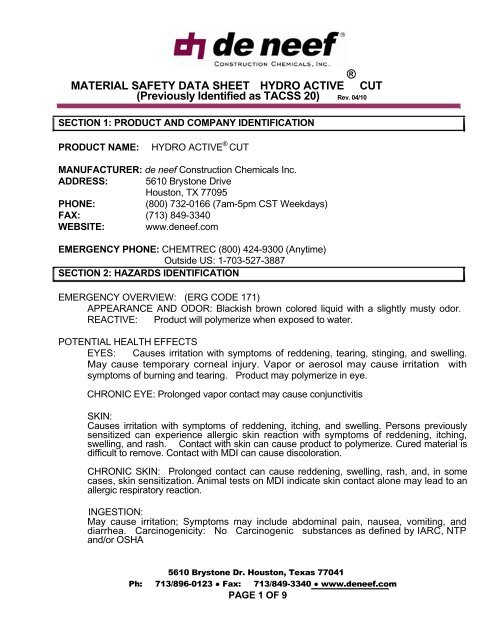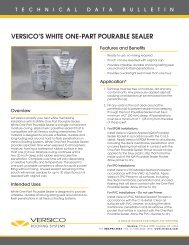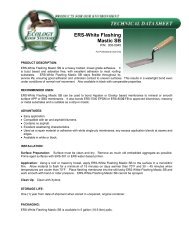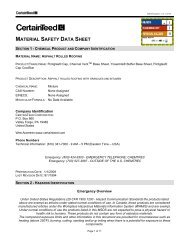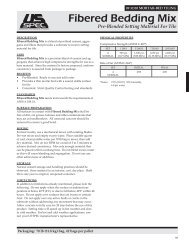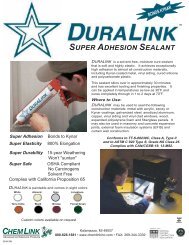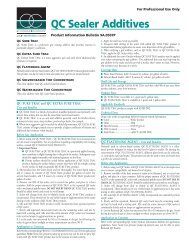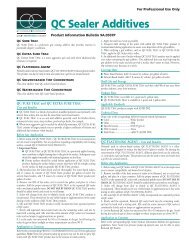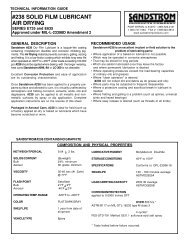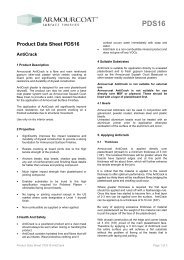MATERIAL SAFETY DATA SHEET HYDRO ACTIVE CUT ...
MATERIAL SAFETY DATA SHEET HYDRO ACTIVE CUT ...
MATERIAL SAFETY DATA SHEET HYDRO ACTIVE CUT ...
You also want an ePaper? Increase the reach of your titles
YUMPU automatically turns print PDFs into web optimized ePapers that Google loves.
®<br />
<strong>MATERIAL</strong> <strong>SAFETY</strong> <strong>DATA</strong> <strong>SHEET</strong> <strong>HYDRO</strong> <strong>ACTIVE</strong> <strong>CUT</strong><br />
(Previously Identified as TACSS 20) Rev. 04/10<br />
SECTION 1: PRODUCT AND COMPANY IDENTIFICATION<br />
PRODUCT NAME: <strong>HYDRO</strong> <strong>ACTIVE</strong> ® <strong>CUT</strong><br />
MANUFACTURER: de neef Construction Chemicals Inc.<br />
ADDRESS: 5610 Brystone Drive<br />
Houston, TX 77095<br />
PHONE: (800) 732-0166 (7am-5pm CST Weekdays)<br />
FAX: (713) 849-3340<br />
WEBSITE: www.deneef.com<br />
EMERGENCY PHONE: CHEMTREC (800) 424-9300 (Anytime)<br />
Outside US: 1-703-527-3887<br />
SECTION 2: HAZARDS IDENTIFICATION<br />
EMERGENCY OVERVIEW: (ERG CODE 171)<br />
APPEARANCE AND ODOR: Blackish brown colored liquid with a slightly musty odor.<br />
RE<strong>ACTIVE</strong>: Product will polymerize when exposed to water.<br />
POTENTIAL HEALTH EFFECTS<br />
EYES: Causes irritation with symptoms of reddening, tearing, stinging, and swelling.<br />
May cause temporary corneal injury. Vapor or aerosol may cause irritation with<br />
symptoms of burning and tearing. Product may polymerize in eye.<br />
CHRONIC EYE: Prolonged vapor contact may cause conjunctivitis<br />
SKIN:<br />
Causes irritation with symptoms of reddening, itching, and swelling. Persons previously<br />
sensitized can experience allergic skin reaction with symptoms of reddening, itching,<br />
swelling, and rash. Contact with skin can cause product to polymerize. Cured material is<br />
difficult to remove. Contact with MDI can cause discoloration.<br />
CHRONIC SKIN: Prolonged contact can cause reddening, swelling, rash, and, in some<br />
cases, skin sensitization. Animal tests on MDI indicate skin contact alone may lead to an<br />
allergic respiratory reaction.<br />
INGESTION:<br />
May cause irritation; Symptoms may include abdominal pain, nausea, vomiting, and<br />
diarrhea. Carcinogenicity: No Carcinogenic substances as defined by IARC, NTP<br />
and/or OSHA<br />
5610 Brystone Dr. Houston, Texas 77041<br />
Ph: 713/896-0123 ● Fax: 713/849-3340 ● www.deneef.com<br />
PAGE 1 OF 9
®<br />
<strong>MATERIAL</strong> <strong>SAFETY</strong> <strong>DATA</strong> <strong>SHEET</strong> <strong>HYDRO</strong> <strong>ACTIVE</strong> <strong>CUT</strong><br />
(Previously Identified as TACSS 20) Rev. 04/10<br />
SECTION 2: HAZARDS IDENTIFICATION (Continued)<br />
INHALATION:<br />
Diisocyanate vapors or mist can irritate (burning sensation) the<br />
mucous membranes in the respiratory tract (nose, throat, lungs) causing runny<br />
nose, sore throat, coughing, chest discomfort, shortness of breath and reduced<br />
lung function (breathing obstruction).<br />
CHRONIC INHALATION<br />
As a result of previous repeated overexposures or a single large dose, certain<br />
individuals may develop sensitization to diisocyanates (asthma or asthma-like<br />
symptoms).<br />
SECTION 3: HAZARDOUS INGREDIENTS<br />
Name CAS NO. % wt/wt<br />
Di-N-Butyl Phthalate 84-74-2 30%-60%<br />
4,4'-Diphenylmethane Diisocyanate 101-68-8 12% - 14%<br />
SECTION 4: FIRST AID MEASURES<br />
EYES: Immediately flush eyes gently with water for at least 15 minutes, while holding<br />
open upper and lower lids. Product will react with moisture in eye! Immediately seek<br />
medical attention.<br />
SKIN: Remove contaminated clothing. Blot or brush the product away, prior to washing<br />
the exposed area with water. The cured product on the skin is rarely a cause of<br />
irritation (If it does, seek medical attention). The process of trying to remove the cured<br />
product may cause irritation.<br />
INGESTION: SEEK IMMEDIATE MEDICAL ATTENTION! DELAYED TREATMENT<br />
MAY RESULT IN FATALITY. Do Not Induce Vomiting. Rinse mouth out with water.<br />
Aspiration of material into the lungs due to vomiting can cause chemical pneumonitis<br />
which can be fatal.<br />
5610 Brystone Dr. Houston, Texas 77041<br />
Ph: 713/896-0123 ● Fax: 713/849-3340 ● www.deneef.com<br />
PAGE 2 OF 9
®<br />
<strong>MATERIAL</strong> <strong>SAFETY</strong> <strong>DATA</strong> <strong>SHEET</strong> <strong>HYDRO</strong> <strong>ACTIVE</strong> <strong>CUT</strong><br />
(Previously Identified as TACSS 20) Rev. 04/10<br />
SECTION 4: FIRST AID MEASURES (continued)<br />
INHALATION: Move to an area free from further exposure. Get medical attention<br />
immediately. Administer oxygen or artificial respiration as needed. Asthmatic symptoms<br />
may develop and may be immediate or delayed up to several hours. Extreme asthmatic<br />
reactions can be life threatening.<br />
SECTION 5: FIRE-FIGHTING MEASURES (ERG CODE 171)<br />
FLASH POINT & METHOD USED:<br />
ASTM D93 365°F (185ºC)<br />
EXTINGUISHING MEDIA:<br />
Dry Chemical, CO2, Foam or Water Fog<br />
SPECIAL FIRE FIGHTING PROCEDURES:<br />
Do not scatter material with high pressure water streams. Firefighters should wear NFPA<br />
compliant structural firefighting protective equipment, including self-contained<br />
breathing apparatus and NFPA compliant helmet, hood, boots and gloves. Avoid contact with<br />
product. Decontaminate equipment and protective clothing prior to reuse. During a fire,<br />
isocyanate vapors and other irritating, highly toxic gases may be generated by thermal<br />
decomposition or combustion. Exposure to heated diisocyanate can be extremely dangerous<br />
Closed container may forcibly rupture under extreme heat or when contents are contaminated<br />
with water (CO2 formed). Use cold-water spray to cool fire-exposed containers to minimize the<br />
risk of rupture. Large fires can be extinguished with large volumes of water applied from a<br />
safe distance, since reaction between water and hot diisocyanate can be vigorous.<br />
HAZARDOUS DECOMPOSITION PRODUCTS:<br />
Fire or intense heat will decompose the product into CO2, CO, Hydrogen Cyanide, Oxides of<br />
Nitrogen, Isocyanates, Isocyanic Acid, and dense black smoke.<br />
SECTION 6: ACCIDENTAL RELEASE MEASURES ( ERG CODE 171)<br />
ACCIDENTAL RELEASE MEASURES: Where exposure level is known, wear approved<br />
respirator suitable for the level of exposure. If exposure level is unknown, wear approved,<br />
positive pressure, self-contained respirator. In addition to the protective clothing in section 8,<br />
wear impermeable boots.<br />
CLEAN-UP PROCEDURES: Remove sources of ignition. Stop and contain / dam the spill.<br />
Absorb spill with inert material (vermiculite / diatomaceous earth). Shovel material into<br />
appropriate container for disposal.<br />
5610 Brystone Dr. Houston, Texas 77041<br />
Ph: 713/896-0123 ● Fax: 713/849-3340 ● www.deneef.com<br />
PAGE 3 OF 9
®<br />
<strong>MATERIAL</strong> <strong>SAFETY</strong> <strong>DATA</strong> <strong>SHEET</strong> <strong>HYDRO</strong> <strong>ACTIVE</strong> <strong>CUT</strong><br />
(Previously Identified as TACSS 20) Rev. 04/10<br />
SECTION 7: HANDLING AND STORAGE<br />
HANDLING:<br />
Do not breathe vapors, mists, or dusts. Use adequate ventilation to keep airborne isocyanate<br />
levels below the exposure limits. Wear respiratory protection if material is heated, sprayed,<br />
used in a confined space, or if the exposure limit is exceeded. Warning properties (irritation of<br />
the eyes, nose and throat or odor) are not adequate to prevent overexposure from inhalation.<br />
This material can produce asthmatic sensitization upon either single inhalation exposure to a<br />
relatively high concentration or upon repeated inhalation exposures to lower concentrations.<br />
Individuals with lung or breathing problems or prior allergic reactions to isocyanates must not<br />
be exposed to vapor or spray mist. Avoid contact with skin and eyes. Wear appropriate eye<br />
and skin protection.<br />
Wash thoroughly after handling. Do not breathe smoke and gases created by overheating or<br />
burning this material. Decomposition products can be highly toxic and irritating. Store in tightly<br />
closed containers to prevent moisture contamination. Do not reseal if contamination<br />
is<br />
suspected.<br />
STORAGE:<br />
Keep in manufacturer’s sealed<br />
nitrogen packed pail. Maintain storage temperatures between<br />
65ºF<br />
to 86ºF (18ºC to 30ºC).<br />
SECTION 8: EXPOSURE CONTROLS/PERSONAL<br />
PROTECTION Di-N-Butyl Phthalate:<br />
ACGIH TWA 5 mg/m<br />
SHA PEL-TWA: (final) 5 mg/m<br />
3<br />
O<br />
3<br />
4,4'- Diphenylmethane Diisocyanate:<br />
ACGIH PEL-TWA: 0.005 ppm<br />
NIOSH Ceiling: 0.02ppm at 10 minutes<br />
OSHA PEL (vacated)CEILING:<br />
3<br />
0.02 ppm, 0.2mg/m<br />
ENGINEERING CONTROLS:<br />
Normal room ventilation is usually adequate under normal use. Local exhaust should be used to<br />
maintain levels below the TLV whenever MDI is heated, sprayed, or aerosolized. Standard<br />
reference sources regarding industrial ventilation (e.g., ACGIH Industrial Ventilation Manual)<br />
should be consulted for guidance about adequate ventilation. To ensure that published<br />
exposure limits have not been exceeded, monitoring for airborne diisocyanate should become<br />
part of the overall employee exposure characterization program.<br />
5610 Brystone Dr. Houston, Texas 77041<br />
Ph: 713/896-0123 ● Fax: 713/849-3340<br />
● www.deneef.com<br />
PAGE 4 OF 9
®<br />
<strong>MATERIAL</strong> <strong>SAFETY</strong> <strong>DATA</strong> <strong>SHEET</strong> <strong>HYDRO</strong> <strong>ACTIVE</strong> <strong>CUT</strong><br />
(Previously Identified as TACSS 20) Rev. 04/10<br />
SECTION 8: EXPOSURE CONTROLS/PERSONAL PROTECTION (continued)<br />
INHALATION:<br />
Diisocyanate vapors or mist at concentrations above the TLV or PEL can irritate<br />
(burning sensation) the mucous membranes in the respiratory tract (nose, throat,<br />
lungs) causing runny nose, sore throat, coughing, chest discomfort, shortness of<br />
breath and reduced lung function (breathing obstruction). Persons with a preexisting,<br />
nonspecific bronchial hyper reactivity can respond to concentrations below the TLV or<br />
PEL with similar symptoms as well as asthma attack or asthma-like symptoms.<br />
Exposure well above the TLV or PEL may lead to bronchitis, bronchial spasm and<br />
pulmonary edema (fluid in lungs). Chemical or hypersensitivity pneumonitis, with flu-<br />
like symptoms (e.g., fever, chills), has also been reported. These symptoms can be<br />
delayed up to several hours after exposure. These effects are usually reversible.<br />
CHRONIC INHALATION<br />
As a result of previous repeated overexposures or a single large dose, certain<br />
individuals may develop sensitization to diisocyanates (asthma or asthma-like<br />
symptoms) that may cause them to react to a later exposure to diisocyanates at levels<br />
well below the TLV or PEL. These symptoms, which can include chest tightness,<br />
wheezing, cough, shortness of breath or asthmatic attack, could be immediate or<br />
delayed up to several hours after exposure. Extreme asthmatic reactions can be life<br />
threatening. Similar to many non-specific asthmatic responses, there are reports that<br />
once sensitized an individual can experience these symptoms upon exposure to dust,<br />
cold air or other irritants. This increased lung sensitivity can persist for weeks and in<br />
severe cases for several years. Sensitization can be permanent.<br />
Chronic overexposure to diisocyanates has also been reported to cause<br />
lung damage (including fibrosis, decrease in lung function) that may be<br />
permanent.<br />
RESPIRATORY PROTECTION:<br />
Airborne MDI concentrations greater than the ACGIH TLV-TWA (TLV) or OSHA PEL-C<br />
(PEL) can occur in inadequately ventilated environments when MDI is<br />
sprayed, aerosolized, or heated. In such cases, respiratory protection must be worn. The<br />
type of respiratory protection selected must comply with the requirements set forth in<br />
OSHA's Respiratory Protection Standard (29 CFR 1910.134). The type of respiratory<br />
protection available includes (1) an atmosphere-supplying respirator such as a<br />
self-contained breathing apparatus (SCBA) or a supplied air respirator (SAR) in the<br />
positive pressure or continuous flow mode, or (2) an air-purifying respirator (APR). If an<br />
APR is selected then (a) the cartridge must be equipped with an end-of-service life<br />
indicator (ESLI) certified by NIOSH, or(b) a change out schedule, based on objective<br />
information or data that will ensure that the cartridges are changed<br />
out before the end<br />
5610 Brystone Dr. Houston, Texas 77041<br />
Ph: 713/896-0123 ● Fax: 713/849-3340 ● www.deneef.com<br />
PAGE 5 OF 9
®<br />
<strong>MATERIAL</strong> <strong>SAFETY</strong> <strong>DATA</strong> <strong>SHEET</strong> <strong>HYDRO</strong> <strong>ACTIVE</strong> <strong>CUT</strong><br />
(Previously Identified as TACSS 20) Rev. 04/10<br />
SECTION 8: EXPOSURE CONTROLS/PERSONAL PROTECTION (continued)<br />
of their service life, must be developed and implemented. The basis for the change out<br />
schedule must be described in the written respirator program. Further, if an APR is<br />
selected, the airborne diisocyanate concentration must be no greater than 10 times the<br />
TLV or PEL. The recommended APR cartridge is an organic vapor/particulate filter<br />
combination cartridge (OV/P100).<br />
EYE PROTECTION: Safety goggles or face shield<br />
SKIN PROTECTION: Use gloves; wear protective clothing to prevent skin contact. In<br />
cured form, the product is difficult to remove from skin and hair.<br />
WORK HYGIENIC PRACTICES: Use good hygiene practices when handling this<br />
material including changing and laundering of work clothes after use.<br />
SECTION 9: PHYSICAL AND CHEMICAL PROPERTIES<br />
APPEARANCE: Blackish brown<br />
ODOR: Slightly musty odor<br />
ODOR THRESHOLD: Not available<br />
PHYSICAL STATE: Liquid<br />
pH: Neutral<br />
MELTING PT:
®<br />
<strong>MATERIAL</strong> <strong>SAFETY</strong> <strong>DATA</strong> <strong>SHEET</strong> <strong>HYDRO</strong> <strong>ACTIVE</strong> <strong>CUT</strong><br />
(Previously Identified as TACSS 20) Rev. 04/10<br />
SECTION 10: STABILITY AND REACTIVITY (continued)<br />
HAZARDOUS DECOMPOSITION OR BY-PRODUCTS: Fire or intense heat will decompose the<br />
product into CO2, CO, Hydrogen Cyanide, Oxides of Nitrogen, Isocyanates, Isocyanic Acid, and<br />
dense black smoke.<br />
During normal polymerization CO2 is produced.<br />
HAZARDOUS POLYMERIZATION: During normal polymerization CO2 is produced.<br />
SECTION 11: TOXICOLOGICAL INFORMATION<br />
CARCINOGENICITY:<br />
4,4'-Diphenylmethane Diisocyanate<br />
IARC: Group 3 (not classifiable as to its carcinogenicity in humans)<br />
EPA- CBD<br />
MAK: 4<br />
Di-N-Butyl Phthalate<br />
IARC: Group 3 (not classifiable as to its carcinogenicity in humans)<br />
EPA: Group D<br />
A<strong>CUT</strong>E TOXICITY<br />
4,4'-Diphenylmethane Diisocyanate<br />
Oral LD50 (rat) >5800 mg/kg<br />
Inhalation LC50 (rat) : 14ppm/4hrs<br />
Dermal LD50 (rabbit) : >16 mL/kg<br />
Di-N-Butyl Phthalate<br />
Oral LD50 (rat) 6300 mg/kg<br />
Inhalation LC50 (rat) > 15mg/L/4hrs<br />
Dermal LD50 (rabbit): >2000 mg/kg<br />
SECTION 12: ECOLOGICAL INFORMATION<br />
Does not Bioaccumulate (All Ingredients)<br />
Biodegrade to 0% in 28 days (4,4'- Diphenylmethane Diisocyanate)<br />
Biodegrade to 40% - 0% in 28 days (Dibutyl Phthalate)<br />
Biodegrade to 70% compressive strength in 80 years (cured foam state)<br />
5610 Brystone Dr. Houston, Texas 77041<br />
Ph: 713/896-0123 ● Fax: 713/849-3340 ● www.deneef.com<br />
PAGE 7 OF 9
<strong>MATERIAL</strong> <strong>SAFETY</strong> <strong>DATA</strong> <strong>SHEET</strong> <strong>HYDRO</strong> <strong>ACTIVE</strong> <strong>CUT</strong><br />
Rev. 04/10<br />
(Previously Identified as TACSS 20)<br />
SECTION 12: ECOLOGICAL INFORMATION continued<br />
Di-N-Butyl Phthalate 84-74-2<br />
Ecotoxicity:<br />
EC50 (freshwater algae): 72 hr Scenedesmus subspicadus:<br />
96 hr Selenastrum capricornutum:<br />
LC50 (freshwater fish): 96 hr Pimephales promelas:<br />
96 hr Pimephales promelas:<br />
96 hr Oncorhynchus mykiss:<br />
96 hr Lepomis macrochirus:<br />
96 hr Lepomis macrochirus:<br />
96 hr Leuciscus idus:<br />
EC50 (Microtox Data )<br />
EC50 (water flea)<br />
1.2 mg/L<br />
0.75 mg/L<br />
0.71 mg/L (flow-through)<br />
1.0 mg/L (static)<br />
1.24 mg/L (flow-through)<br />
0.42 mg/L (flow-through)<br />
0.7 mg/L (static)<br />
4.6 mg/L (static<br />
5 min Photobacterium Phosphoreum: 10.9 mg/L<br />
15 min Photobacterium Phosphoreum: 11.1 mg/L<br />
30 min Photobacterium Phosphoreum: 10.9 mg/L<br />
24 hr tetrehymena pyriformis: 2.2 mg/L<br />
48 hr water flea: 3.7 mg/L (static)<br />
48 hr Daphnia magna: 3.4 mg/L<br />
SECTION 13: DISPOSAL CONSIDERATIONS<br />
Waste Disposal Method<br />
Waste disposal should be in accordance with existing federal, state and local environmental<br />
control laws. Incineration is the preferred method.<br />
Empty Container Precautions<br />
Empty containers retain product residue; observe all precautions for product. Do not heat or cut<br />
empty container with electric or gas torch because highly toxic vapors and gases are formed. Do<br />
not reuse without thorough commercial cleaning and reconditioning. If container is to be disposed,<br />
ensure all product residues are removed prior to disposal. Dispose of per local, state and federal<br />
guidelines as required by your specific local. This product in its cured foam state is inert and<br />
non-toxic.<br />
SECTION 14: TRANSPORT INFORMATION<br />
Follow all applicable shipping regulations. Contact de neef Construction Chemicals Inc. for any<br />
further information.<br />
5610 Brystone Dr. Houston, Texas 77041<br />
Ph: 713/896-0123 ● Fax: 713/849-3340 ● www.deneef.com<br />
PAGE 8 OF 9
®<br />
<strong>MATERIAL</strong> <strong>SAFETY</strong> <strong>DATA</strong> <strong>SHEET</strong> <strong>HYDRO</strong> <strong>ACTIVE</strong> <strong>CUT</strong> Rev. 05/ 09<br />
SECTION 15: REGULATORY INFORMATION<br />
U.S. FEDERAL REGULATIONS<br />
Ingredient TSCA CERCLA<br />
RQ<br />
302<br />
SARA<br />
313<br />
Di-N-Butyl Phthalate Yes 10 lbs No Yes<br />
4,4'- Diphenylmethane Diisocyanate Yes 5000 lbs No Yes<br />
TSCA: All ingredients are listed in or exempt from the TSCA Master Inventory File<br />
WHMIS:<br />
All ingredients are listed on the CEPA Domestic Substances List (DSL)<br />
Ingredient Disclosure List (IDL), the following components are on the list:<br />
Di-N-Butyl Phthalate 84-74-2<br />
4,4'- Diphenylmethane Diisocyanate 101-68-8<br />
SECTION 16: OTHER INFORMATION<br />
NFPA HAZARD CLASSIFICATION:<br />
HEALTH: 2 FLAMMABILITY: 1<br />
REACTIVITY:<br />
1 HMIS:<br />
HEALTH: 2 FLAMMABILITY: 1 PHYSICAL HAZARD:<br />
1<br />
PREPARATION INFORMATION:<br />
April 2010<br />
This MSDS is on a three year review cycle. If the date on this sheet is older than three years<br />
please contact de neef Construction Chemicals Inc. for an updated MSDS.<br />
DISCLAIMER:<br />
All information appearing herein is based on manufacturer and/ or recognized technical sources.<br />
While the information is believed accurate de neef Construction Chemicals Inc. makes no<br />
representations as to the accuracy or sufficiency of the information.<br />
5610 Brystone Dr. Houston, Texas 77041<br />
Ph: 713/896-0123 ● Fax: 713/849-3340 ● www.deneef.com<br />
PAGE 9 OF 9


